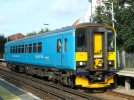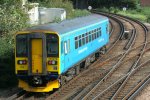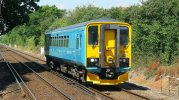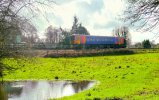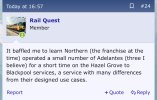-
Our new ticketing site is now live! Using either this or the original site (both powered by TrainSplit) helps support the running of the forum with every ticket purchase! Find out more and ask any questions/give us feedback in this thread!
You are using an out of date browser. It may not display this or other websites correctly.
You should upgrade or use an alternative browser.
You should upgrade or use an alternative browser.
I didn’t know they had that!! Rolling stock you didn’t know that company operated.
- Thread starter generalnerd
- Start date
Sponsor Post - registered members do not see these adverts; click here to register, or click here to log in
R
RailUK Forums
trainmania100
Established Member
Gbrf and class 73s. They obviously serve their purpose with RHTT etc for a short part of the year, but by the end of the season just gone most of the workings (including W90) were covered by 69s anyway. There was even a few 66 workings.
With more 69s still rolling off the production line and new gbrf locos on their way, I can't see 73s been used much longer ....
I guess their main benefit is the 3rd rail.
With more 69s still rolling off the production line and new gbrf locos on their way, I can't see 73s been used much longer ....
I guess their main benefit is the 3rd rail.
Indeed. They offer a very useful ‘green’ credential, I wouldn’t be at all surprised if that buys them a good few years more use doing circuits on the southern. This is particularly relevant when you consider locations which are actively ‘anti-diesel’, like certain London terminals etc; presumably that stance is only likely to expand as the years go by. I’d imagine a 73 also likely has much better route availability than a large heavy diesel?Gbrf and class 73s. They obviously serve their purpose with RHTT etc for a short part of the year, but by the end of the season just gone most of the workings (including W90) were covered by 69s anyway. There was even a few 66 workings.
With more 69s still rolling off the production line and new gbrf locos on their way, I can't see 73s been used much longer ....
I guess their main benefit is the 3rd rail.
There are only 16 Class 69s. The majority of RHTTs (in Kent at least) are still hauled by 73s, and there have been no plans to replace them.Gbrf and class 73s. They obviously serve their purpose with RHTT etc for a short part of the year, but by the end of the season just gone most of the workings (including W90) were covered by 69s anyway. There was even a few 66 workings.
With more 69s still rolling off the production line and new gbrf locos on their way, I can't see 73s been used much longer ....
I guess their main benefit is the 3rd rail.
Yes, the 73s have very good route availability.Indeed. They offer a very useful ‘green’ credential, I wouldn’t be at all surprised if that buys them a good few years more use doing circuits on the southern. This is particularly relevant when you consider locations which are actively ‘anti-diesel’, like certain London terminals etc; presumably that stance is only likely to expand as the years go by. I’d imagine a 73 also likely has much better route availability than a large heavy diesel?
If you think SWT having 73s is weird, you'll probably find their Class 960 (121) even weirder.What rolling stock would you consider as interesting or unique/you didn’t realise that company owned/operated the rolling stock?
For example, the southwest trains class 73, used for rescue operations:
py_megapixel
Established Member
I remember being taken by surprise on the through platforms at Manchester Piccadilly when a Transpennine service to the airport was announced and a shiny new EMU whizzed into the station, apparently fresh out of the factory (it hadn't even had the vinyl livery put on yet), in place of the expected 185!
Sun Chariot
Established Member
They've done sterling work along the West Coastway route (West Sussex-Hampshire): Railhead Treatment, Snow & Ice Treatment, Network Rail inspection, plus route learning out Tonbridge and out Crawley.Gbrf and class 73s.
Last edited:
Class15
Established Member
Most of the 3W75/3W90 RHTT circuits last year were 69s which was a trend on all Tonbridge RHTTs from what I have seen.There are only 16 Class 69s. The majority of RHTTs (in Kent at least) are still hauled by 73s, and there have been no plans to replace them.
Another example: I was amazed to find out that London Overground had Class 508s. Apparently they even had to be hauled into Willesden depot by a 313 due to no third rail!
Bringback309s
Member
- Joined
- 22 Aug 2013
- Messages
- 335
The Hornsey shunter! http://ukrailways1970tilltoday.me.uk/NVR2008DdayMarch4.html
This class 03 was based at First Capital Connects Hornsey Depot in 2008 . It job was move the EMUs about the depot. This was only when there was no overhead electricity or the EMU pantograph was not working or damaged or some other fault that meant it could move under its own power.
The class 3 did just a a few miles around the yard at Horsey, is why it was so clean or had it been doon up for it visit to the NVR.
Last edited by a moderator:
Sun Chariot
Established Member
Knights Rail Services (Eastleigh): 07007. I was astonished to see it, in BR Blue livery, when I flew into Southampton Airport 5 years ago.The Hornsey shunter! http://ukrailways1970tilltoday.me.uk/NVR2008DdayMarch4.html
Until I first saw them in spring 2023, I hadn't realised Network Rail was using class 153s for track inspection.
153385 and 'blue brick' 153376 have been fairly regular along the West Coastway and Portsmouth Direct lines.
Attachments
Last edited:
Gbrf and class 73s. They obviously serve their purpose with RHTT etc for a short part of the year, but by the end of the season just gone most of the workings (including W90) were covered by 69s anyway. There was even a few 66 workings.
With more 69s still rolling off the production line and new gbrf locos on their way, I can't see 73s been used much longer ....
I guess their main benefit is the 3rd rail.
They are of course used by GBRf on the Caledonian Sleeper.
Warrior2852
Member
- Joined
- 27 Oct 2018
- Messages
- 176
I do find it amusing how Network Rail sometimes doesn't repaint stock they've acquired from elsewhere, like with the ex-EMT 153 here, leading to finding some heritage liveries that have disappeared from everywhere else still among their ranks.Until I first saw them in spring 2023, I hadn't realised Network Rail was using class 153s for track inspection.
153385 and 'blue brick' 153376 have been fairly regular along the West Coastway and Portsmouth Direct lines.
Knights Rail Services (Eastleigh) - 07007. I was astonished to see it, when I flew into Southampton Airport 5 years ago.
CaramellDansen
On Moderation
I wonder, given Merseyrail's desire for more unelectrified expansions, if 3rd-rail/diesel bi-mode loco(s) would be of interest to them! Not sure how else they'd rescue a failed battery loco!For example, the southwest trains class 73, used for rescue operations:
(They could always put some bloody wires above the tracks!!
Deepgreen
Established Member
Class 701s, supposedly operated by SWR...
Never alone now, though?They are of course used by GBRf on the Caledonian Sleeper.
In the early 90s Merseyrail aquired 5 Class 73s (4 active and one parts source) that were used for departmental, engineering, and sandite duties (two that were renumbered into 73/9s). They were all withdrawn by 2002 and sold into preservation (the 73/9s were converted back to 73/0s and later sold on to GBRf to be converted into their 73/9 'Ultra' configuration).I wonder, given Merseyrail's desire for more unelectrified expansions, if 3rd-rail/diesel bi-mode loco(s) would be of interest to them! Not sure how else they'd rescue a failed battery loco!
Maybe not aware (purpose of this thread) that previously there was indeed a small fleet of Class 73 which were on Merseyside for quite some years after the Liverpool Loop opened, they replaced equally odd battery service stock rebuilt from Euston-Watford Class 501 trains, being there in the 1980s-90s, although I never saw them move from outside Birkenhead North depot.I wonder, given Merseyrail's desire for more unelectrified expansions, if 3rd-rail/diesel bi-mode loco(s) would be of interest to them! Not sure how else they'd rescue a failed battery loco!
12LDA28C
Established Member
Never alone now, though?
Occasionally, yes although more usually in pairs.
Davester50
Member
Aberdeen portion often is.Never alone now, though?
xotGD
Established Member
- Joined
- 4 Feb 2017
- Messages
- 6,793
Am I right in thinking that GBRF have a Class 47?
Class15
Established Member
They used to have threeAm I right in thinking that GBRF have a Class 47?
Rail Quest
Member
It baffled me to learn Northern (whatever the franchise at the time) operated a small number of Adelantes (three I believe) for a short time on the Hazel Grove to Blackpool services, a service with many differences from their designed use cases.
Last edited:
Sun Chariot
Established Member
Yes: three. I photo'd two of them: 727 and 749.Am I right in thinking that GBRF have a Class 47?
hexagon789
Veteran Member
Also did Manchester Vic/BlackpoolIt baffled me to learn Northern (the franchise at the time) operated a small number of Adelantes (three I believe) for a short time on the Hazel Grove to Blackpool services, a service with many differences from their designed use cases.
CaramellDansen
On Moderation
You don't say! Thanks for the shout, and the pictures!In the early 90s Merseyrail aquired 5 Class 73s (4 active and one parts source) that were used for departmental, engineering, and sandite duties (two that were renumbered into 73/9s). They were all withdrawn by 2002 and sold into preservation (the 73/9s were converted back to 73/0s and later sold on to GBRf to be converted into their 73/9 'Ultra' configuration).
I wonder what they're using now
How bizarre! That's certainly news to me!they replaced equally odd battery service stock rebuilt from Euston-Watford Class 501 trains, being there in the 1980s-90s
generalnerd
Member
D365
Veteran Member
- Joined
- 29 Jun 2012
- Messages
- 12,148
Indeed. The Brush modified 73/9s are the only diesels currently available which are compatible with the coach control/communication systems.They are of course used by GBRf on the Caledonian Sleeper.
hexagon789
Veteran Member
They were short of stock and they were available. Eventually some ex-London Midland 150s were transferred and the 180s withdrawn.Oh wow! I wonder why? (It didn’t reply and didn’t work so pretend the image attached is the original post)


